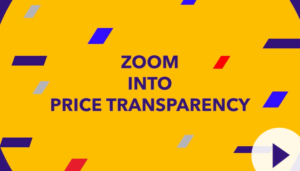
Kaitlin Howard is a researcher and writer producing insightful content across the healthcare revenue cycle. She has written and produced content for Zelis, Waystar, and Recondo Technology, as well as agencies. With a B.A. in English and Writing from University of Denver, Kaitlin stays current on market updates on claims management and healthcare payments, publishing a regular educational blog series on industry trends and Zelis offerings.
With price transparency on the rise, healthcare is becoming increasingly consumer-centric. There’s no secret there.
In fact, the No Surprises Act (NSA), signed into law in December 2020, seeks to protect patients from surprise medical bills and prohibits balance billing for certain out-of-network care. The Transparency in Coverage Rule (TiC), published October 2020, provides consumers better insight into the cost of services before obtaining care and receiving a bill.
What does this mean for providers?
Healthcare organizations must now create a consumerism strategy that highlights price transparency to meet both NSA and TiC compliance, while still improving the patient experience and accelerating cash.
But that’s not all. Your strategy must demonstrate that you actually care.
Price transparency itself is not a goal. Rather, it’s a means toward multiple goals around your patients and your bottom line, like avoiding sticker shock, facilitating shopping, and lifting the veil on high prices. It is only after achieving these goals geared toward patient experience that you can achieve your other goal: actually getting paid.
And while these new requirements will add complexity to healthcare claim processing and administration, both pre- and post-service, these rulings’ most significant impact lies in two key areas: transparency and member engagement and out-of-network (OON) claim processing and payment.
But we know what you’re thinking. Those deadlines for compliance are rapidly approaching. And it’s difficult to know where to begin.
Price Transparency Best Practices for Providers
1. Do right by your patients.
In a recent survey, almost two-thirds of patients reported that there is not enough information regarding the cost of medical services before the time of service. Providing patients with the out-of-pocket cost before they get care helps them prepare for its financial impact. No more “surprise you owe this much!”. Hello, public trust in the health care system (and, more importantly, in your organization).
Accurately estimating out-of-pocket costs and having pre-service financial discussions to answer patient questions puts you one step ahead of your competitors, one step toward compliance, and one step closer to accelerating your cash.
You read that right. Having pre-service financial discussions accelerates your cash.
When a patient is notified of their portion of the bill upfront, they are able to take the steps they need to find the money to pay prior to service. And when patients pay a portion of their balance pre-service, they are more likely to pay the remainder of the bill. That’s why it is so important to determine and share the price of the patient encounter before the day of service.
2. Facilitate shopping around.
While 70% of patients would like to discuss costs with their providers, only 28% of them said doctors or their staff brought up a price conversation with them prior to service. Those are rookie numbers, to say the least.
Consumerism is a huge goal of price transparency. Plain and simple. Under the consumerism model, patients are expected to compare prices and quality between organizations. But the use of price transparency tools is not yet common enough to affect overall healthcare spending.
So how can you help? Make your pricing tools more easily accessible and user-friendly. Don’t have any of these tools set in place, yet? Get some.
Price shopping impacts patient decisions about where to receive their care. If you have tools in place to ensure that your prices are readily available and accessible to patients pre-service, they are more likely to receive care at your organization.
3. Ensure your patients can (and will) pay for the care you provide.
According to a recent Becker’s study, 95% of patients indicate they are willing to pay a bill, while only 20% of provider organizations indicate they have the infrastructure to meet this experience. Which doesn’t balance out well when paired with the fact that about half of the public, regardless of socioeconomic status or health, say they are either “very worried” or “somewhat worried” about being able to afford unexpected medical bills or their health insurance deductible.
What does this mean for payers?
As we’ve mentioned before. Healthcare just got an upgrade. Rather than relying on its highly complex, opaque ways of the past, the healthcare industry is now centering itself around transparency, striving to deliver its patient’s financial experiences in a clear, straightforward way.
The No Surprises Act (NSA) is another push for providers to become more transparent about total patient costs, eliminating surprise medical billing (aka balance billing).
Let’s break it down.
The NSA requires health plans to update provider directories more frequently. Why? If payers can make updates to their directories within 48 hours, as the law mandates, patients suddenly have a much better chance of finding care actually covered by their plan.
Sounds reasonable enough, right?
Now throw in the fact that health plans are processing an avalanche of provider data at any given time. And if that weren’t already enough, let’s remember that this data is not streaming in seamlessly (e.g. through some sort of shared payer / provider platform). Rather, payers are receiving Excel spreadsheets from hundreds of different provider groups, each with their own unique (and ever-changing) template.
As such, these provider directories updates often take weeks, cost millions of dollars annually, and still only have accuracy rates around 60%.
Talk about a problem.
Since plans rely heavily on this information to, not only update their provider directories, but also determine which providers should be paid for contracted rates, specialty and licensing updates, and billing information changes.
Luckily, technology is here to help.
Recent advances in machine learning and artificial intelligence now make it possible to automate the millions of human hours spent cleansing and keying in data every year, while improving its overall accuracy.
Price Transparency Best Practices for Payers
1. Learn more than what automation can do. Learn about what it can’t.
While automation can help with a multitude of issues, what it can’t do is completely solve the global interoperability problem. It can, however, sit between disparate systems as a translator.
Meaning: If an automation tool is given all the information about how humans have been making decisions about processing data, then it can apply that same decision-making framework (albeit in a much more efficient and consistent way).
2. Set realistic goals.
How long is it currently taking you to make provider updates? What percentage of those updates are accurate? What types of issues do you most commonly experience with the data you receive (e.g. frequently missing column headers)?
Just as the answers to these questions will vary payer to payer, so will goals for improvement.
3. Discover the range of solutions available.
As with anything else, not all automation solutions are created equal.
Some require a “rip and replace” approach that you may find disruptive to your existing IT infrastructure, but others will co-exist with and supplement for your current systems. Solutions may also vary in terms of the type of data they can automate. Thus, insurers should be sure to only seek out those capable of dealing with the inherent messiness of human-generated data.
But, most importantly, you should look for an automation partner that provides human support in addition to technology. The right partner can assist with needs assessment and goal-setting, as well as provide guidance on how to document current manual processes.
Let’s Recap
The No Surprises Act and Transparency in Coverage Rule will impact all healthcare organizations, from large health plans and insurance companies to small medical offices and individual providers. As such, leaders across the healthcare industry must directly understand the details of the legislation prior to implementation or have a trusted advisor with legislative expertise who can guide them to appropriate solutions.
Zelis can help. For more information on getting started with your NSA compliance, visit our Info Hub.


